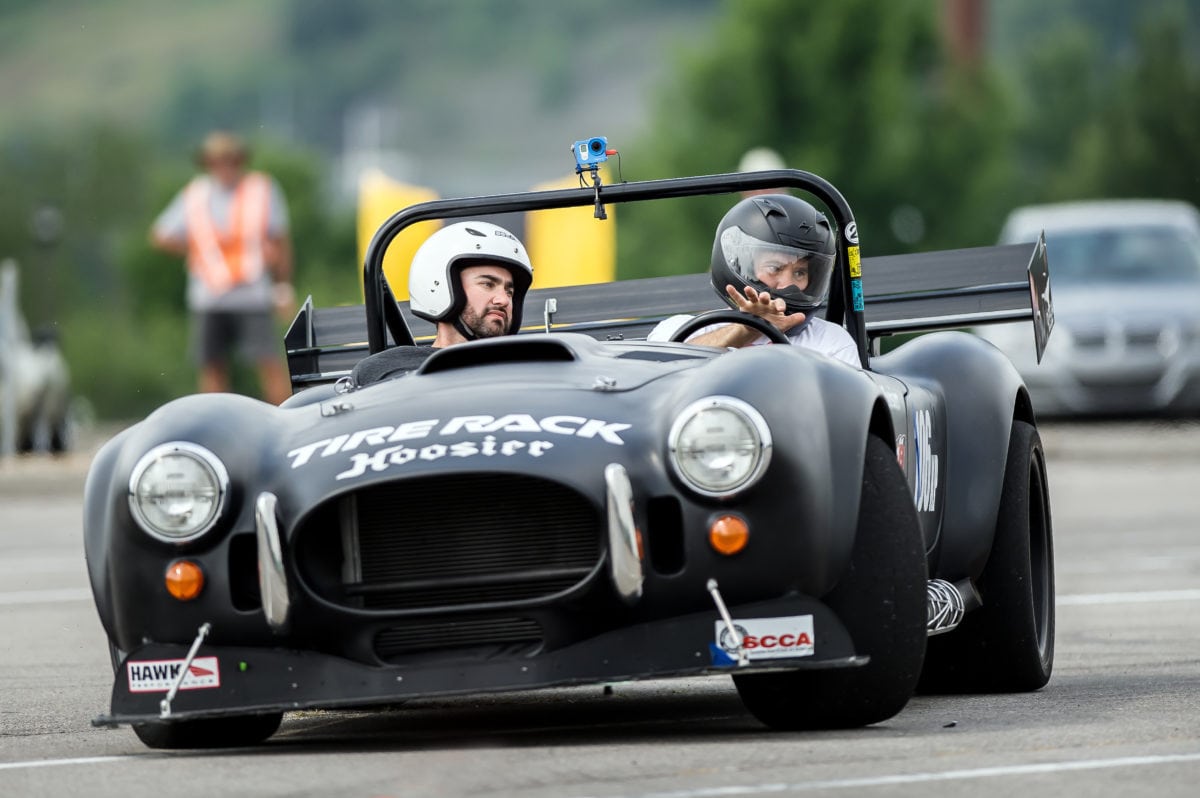 When I was a kid, we had an International Harvester Farmall Cub tractor with split brakes. They had many mundane uses, but as a boy what I used them for was to skid around muddy corners as fast as I could. I’d slam on the left brake, let the right spin, and try to make that left rear tire stick to the ground as I whipped the tractor around the edge of our barn. Turns out, what I was trying to do back then is exactly what you want to achieve in the sport of autocross: to get around the turns as fast as possible. Nearly 40 years later, this is going through my mind as I sit in the passenger seat of Lyonel Kent’s modified BMW M3 on a warm July day, preparing to take my first ride around an autocross track. The desire for speed and the excitement of taking a turn fast are what autocross is all about. This evaluation is echoed by Kent, who simplifies the sport to a simple sentence: “You want to go drive your car as fast as you can through some pylons in a parking lot.”
When I was a kid, we had an International Harvester Farmall Cub tractor with split brakes. They had many mundane uses, but as a boy what I used them for was to skid around muddy corners as fast as I could. I’d slam on the left brake, let the right spin, and try to make that left rear tire stick to the ground as I whipped the tractor around the edge of our barn. Turns out, what I was trying to do back then is exactly what you want to achieve in the sport of autocross: to get around the turns as fast as possible. Nearly 40 years later, this is going through my mind as I sit in the passenger seat of Lyonel Kent’s modified BMW M3 on a warm July day, preparing to take my first ride around an autocross track. The desire for speed and the excitement of taking a turn fast are what autocross is all about. This evaluation is echoed by Kent, who simplifies the sport to a simple sentence: “You want to go drive your car as fast as you can through some pylons in a parking lot.”
—Jeff Cox
Run by the East Tennessee Region Sports Car Club of America (ETRSCCA), the event is laid out in the parking lot of the Smokies stadium in Kodak. As we finished our first run, my adrenaline was up. It had taken only a little over 47 seconds, and it had its nail-biting moments for someone who had never been on a course, but I was ready to go again and that day I ended up riding along with four different drivers in four different cars ranging from a stock Ford Focus to a modified Miata, to Lyone’s M3. In each case, regardless of top speed, the experience was thrilling.
Kent began his more than 20 years in autocross for the opportunity to drive a car to its fullest potential. He caught the bug from one of his friend’s fathers, who first invited him to race, which he did a time or two in high school. He began in earnest when he got out of college and could afford to put some money into it. He put many race miles on a 95 Honda Civic EX that matriculated from college transportation to autocross racecar. Eventually, he moved on to wheel-to-wheel racing, what people think of as a traditional auto race, where you’re battling for the turn and racing for position against as many as seventy other cars on track at the same time.
 Autocross, however, is a solo event—you’re not racing directly against other cars; you’re racing against the clock. The sport welcomes all comers. If you’ve got a car that handles reasonably well, preferably with a manual transmission, you’re ready to go. You only need someone to show you the ropes. Luckily, autocross people are some of the most generous sports nuts I’ve ever met, and they’re positively evangelical about their sport. Erika Deblock, a woman in her 20’s, has been racing autocross for about two-and-a-half years. She currently has a highly modified 2002 Subaru WRX that sadly didn’t make it to the course today. “I love her, says Deblock, “but she’s very liable to break at any moment.” She follows this with the kicker I’d come to expect from the participants: “As soon as I get a trailer, though, I’ll bring it out anyway. I definitely like the community more than anything. Even if you’re not in a car, the people here are always welcoming and fun to be around. The competitive spirit is always happy; no one’s at their throats; it’s always a good time.”
Autocross, however, is a solo event—you’re not racing directly against other cars; you’re racing against the clock. The sport welcomes all comers. If you’ve got a car that handles reasonably well, preferably with a manual transmission, you’re ready to go. You only need someone to show you the ropes. Luckily, autocross people are some of the most generous sports nuts I’ve ever met, and they’re positively evangelical about their sport. Erika Deblock, a woman in her 20’s, has been racing autocross for about two-and-a-half years. She currently has a highly modified 2002 Subaru WRX that sadly didn’t make it to the course today. “I love her, says Deblock, “but she’s very liable to break at any moment.” She follows this with the kicker I’d come to expect from the participants: “As soon as I get a trailer, though, I’ll bring it out anyway. I definitely like the community more than anything. Even if you’re not in a car, the people here are always welcoming and fun to be around. The competitive spirit is always happy; no one’s at their throats; it’s always a good time.”
Also known as SOLO, autocross is a timed event where a car is driven through a course of pylons in a controlled environment. The courses are designed to be as safe as possible so that you’re
not going to ultimately hurt you or your car or other people. Participant Bob Colbert started out in the East Tennessee club in 2010. He notes that “You can’t beat the adrenaline rush. You can go as fast and as far as the car will take you.” The rules are pretty simple: navigate as fast as you can a course laid out with orange traffic cones. You’re docked a two-second penalty for knocking down a cone.

It’s all about the turns. How you navigate them determines how fast your run will be. Mark Pilson, who has been racing with SCCA since 1990, says that in the sport “you get an outlet to come out here and drive aggressive.” Aggressive only to a point, however. An autocross driver wrestles with two forces most of us have encountered when losing control of a vehicle: oversteer, where you attempt a corner and the back end comes out, and understeer, where you try to turn but the car keeps going straight. Depending on whether the car is front or rear-wheel drive, and depending how the car is set up, the driver may be fighting or inducing these situations in order to get around a turn as fast as possible. As Kent puts it, “oversteer is when you don’t see what you’re going to hit. Understeer is when you see what you’re going to hit.”
Cars are placed in multiple classes in order to ensure some form of objective measure—that similar cars can be compared with one another. It can seem complicated, but if you read the ETSRCCA website and trust the experienced drivers, you won’ have any difficulty with the concept. Largely it’s a matter of what kind of car you’re driving and how many modifications have been made to it. Regardless, most of the time, a fast driver in a slow car is going to be faster than a slow driver in a fast car.
With autocross, the barriers to entry are so low like anybody can do it. You can take your mom’s Honda Accord station wagon, show up, and have a blast. It’s based upon a love of speed. As driving enthusiast Dan Pilkington says, “most people got a car up to 120 miles an hour on the interstate when they were sixteen. But going 100 miles an hour and looking at a sharp turn in front of you is different. Going down the road at 60 mph isn’t that fast. Taking a turn at 60 is.”
 As with any interest, technique comes with experience. As Kent notes, “you’re constantly learning,” both from driving and from other drivers. If you drive, though, you’re also expected to work the course and keep the pylons in place, to “shag cones,” as the phrase goes.
As with any interest, technique comes with experience. As Kent notes, “you’re constantly learning,” both from driving and from other drivers. If you drive, though, you’re also expected to work the course and keep the pylons in place, to “shag cones,” as the phrase goes.
What participants walk away with varies. Pilkington says it thus: “When you get around a turn, you get that high like ‘I’m still alive this is great.’ You get back to the stress of your job on Monday and it just makes a difference. My boss is on me, but I almost died two days ago, so I don’t care.” For Kent, it’s a slightly different experience after over 20 years of racing. “I have a stressful job,” he says, “and getting on the race track for me is like my Zen. I’m just totally relaxed on the race track when I’m driving.”
Jeff Cox, with 34 years in law enforcement, has been racing for seven years and seemed to be taking the lead in organizing the day’s event. “It’s the funnest thing you can do in a parking lot and not get put in jail for it. And being in law enforcement, that means something.” He offers an invitation to those interested: “Come out and have fun. You can run anything you’ve got. There’s a class for every car and every car has a class.” Spectators are welcome, too. All you have to do is show up and sign a standard injury, loss, and damage waiver.
They say that racing is an addiction only cured by poverty. In autocross, you can take a long time getting there, though. For now, just show up with your car, and don’t worry about the rest.
